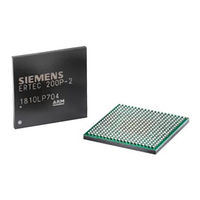Siemens ERTEC 200P Manuals
Manuals and User Guides for Siemens ERTEC 200P. We have 1 Siemens ERTEC 200P manual available for free PDF download: Manual
Siemens ERTEC 200P Manual (501 pages)
Enhanced Real-Time Ethernet Controller
Brand: Siemens
|
Category: Controller
|
Size: 4.41 MB
Table of Contents
-
-
-
-
-
Features26
-
Boot Mode 137
-
-
Endianness44
-
AHB Arbiters45
-
APB Decoder51
-
Interface54
-
Overview54
-
Sequences60
-
-
AHB Interfaces104
-
Details104
-
Job Priorities104
-
Usage114
-
Result115
-
Memory116
-
Interrupts117
-
GDMA-IP Bugs125
-
Address Mapping126
-
-
EMC Notes162
-
Remapping162
-
Read Access164
-
Write Access165
-
Address Mapping169
-
-
Address Mapping189
-
Profinet-Ip230
-
AHB Interface230
-
PN-IP Interfaces230
-
-
-
Clock System236
-
Clock Monitoring238
-
Lock Timer 1238
-
Lock Timer 2238
-
Lock Monitor239
-
Reset System241
-
APB Peripherals247
-
I-Filter248
-
Address Mapping251
-
ARM926 Watchdog260
-
Block Diagram260
-
Overview260
-
Signal Waveforms263
-
Address Mapping265
-
Notes265
-
Overview269
-
Timer 0 - 5269
-
Timer Module273
-
Operating Rules282
-
Address Mapping285
-
F-Counter302
-
Address Mapping303
-
Uart1305
-
UART Baud Rates306
-
Address Mapping308
-
I²C325
-
Address Mapping328
-
SPI Flash Boot343
-
Address Mapping345
-
GPIO Assignment353
-
Address Mapping356
-
Boot Register366
-
Config Register366
-
Reset Registers367
-
Memory Swapping368
-
PHY Register369
-
ARM926 Mapping370
-
EDC Register370
-
SPI Mode373
-
SPI Parity Error373
-
XHIF Mode373
-
Address Mapping374
-
-
Memory Mapping415
-
3 Io Interface
426-
Overview426
-
IO Timing451
-
EMC Timing452
-
-
Separate RD/WR459
-
XHIF Timing459
-
Common RD/WR461
-
SPI Timing463
-
-
PN-IP Timing464
-
MDIO Timing464
-
MII Timing464
-
PHY FX Timing465
-
PHY LED Timing465
-
PNPLL Timing465
-
SPI Timing468
-
UART Timing470
-
GPIO Timing471
-
I²C Timing471
-
I²C - Apb471
-
I²C - Pn-Ip471
-
-
JTAG Timing471
-
-
-
EMC Measures474
-
JTAG Wiring480
-
PHY Wiring481
-
-
5 Package
493-
Package Drawing493
-
Ball Layout493
-
-
Order Codes495
-
-
Solder Profile497
-
-
6 Quality
499 -
7 Miscellaneous
500-
Abbreviations500
-
Literature List501
-
Advertisement
Advertisement
